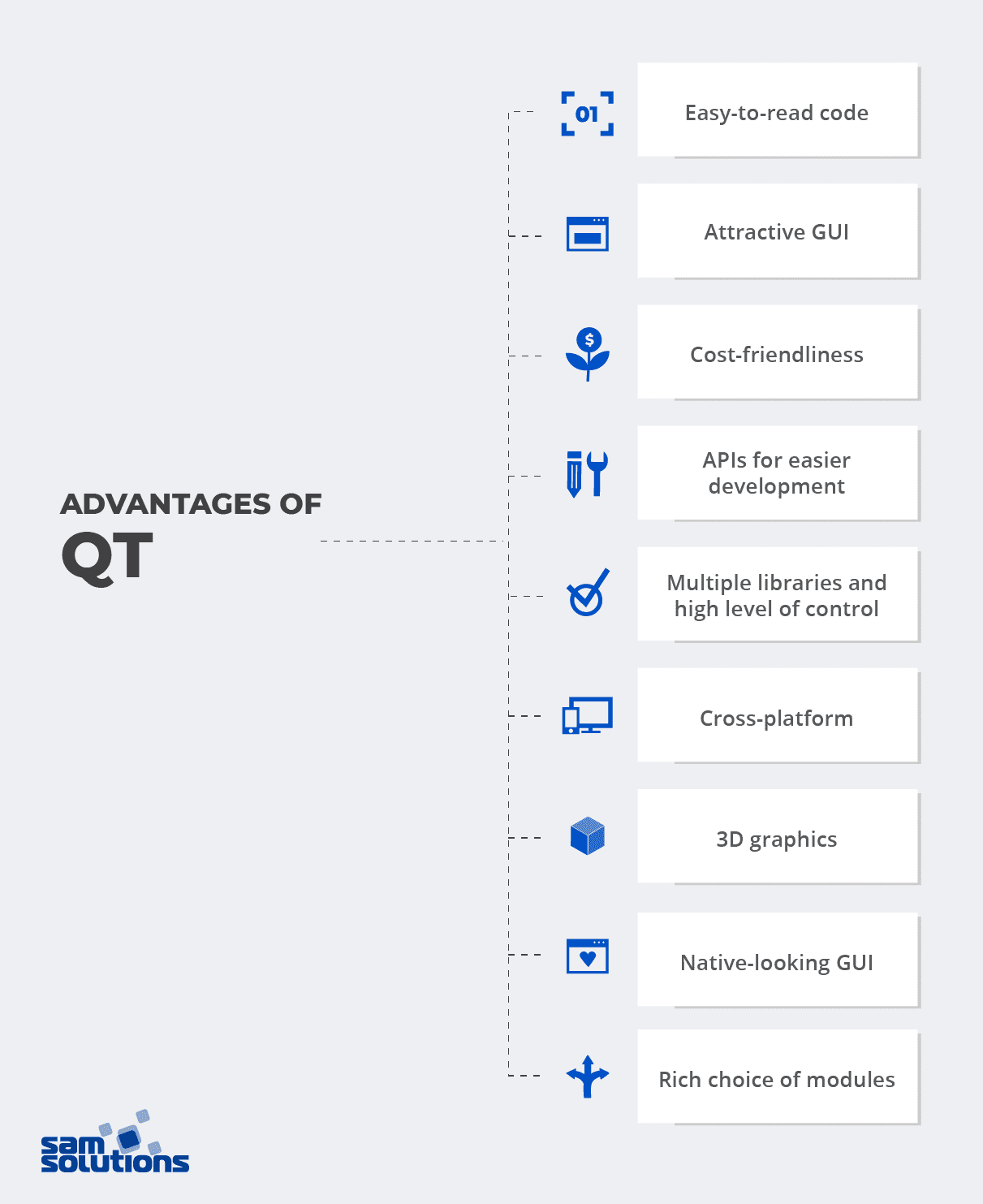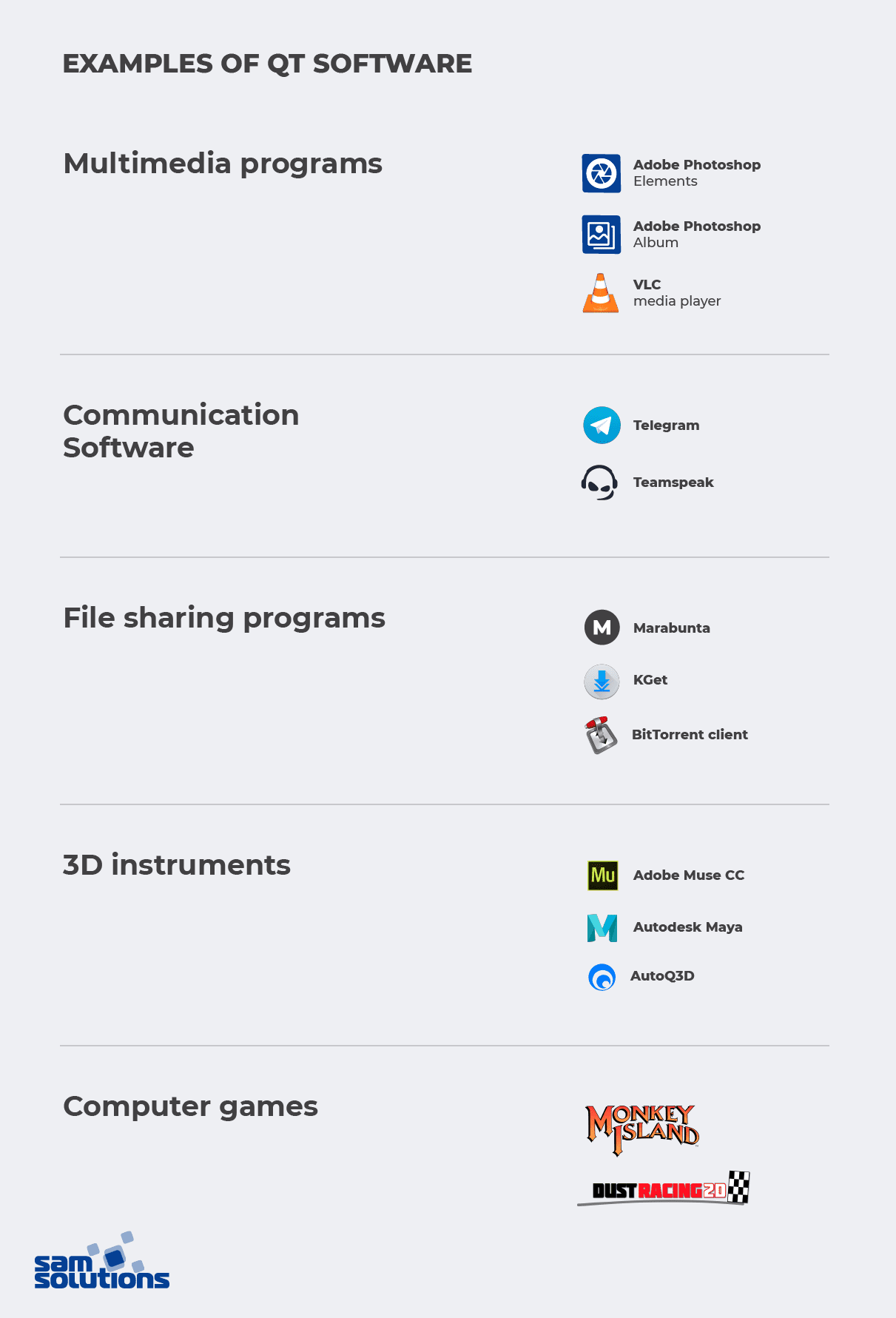Frameworks play in favor of effective app development because of out-of-the-box constituents. Their aim is to help standardize the software development process, making it quicker and easier. Qt framework is a popular solution for GUI development. In this article, we will examine the benefits of Qt and QML implementation in the IT industry.
What Is QT?
Qt is a C++framework for developing graphical user interfaces and cross-platform applications, both desktop and embedded. The framework can function on different types of software and hardware. Initially, it was created as a class library, and over the years the license underwent numerous transformations. Users can choose between two available types of license: a commercial paid license and a free open source license.
We develop custom software and firmware for embedded systems – start your embedded journey today
It offers a special software development language: Qt Modeling Language(QML), which is widely implemented in projects to create user interface–focused apps. In addition, it can be bound with other languages such as:
The Qt Integrated Development Environment (IDE) is known as Qt Creator. To add extra features to Qt, developers often use addon modules in their projects. These can either work with specific platforms only, or are backward-compatible. Some addons are available only in the commercial license. In the free license, there are no such options.
Thanks to the widget toolkit, programmers can code straightaway in C++. Qt Designer can generate code for widget-based graphical user interface software in interactive mode. A special instrument called the Qt Quick module streamlines GUI development with the help of QML.
As of today, there are 4 editions on the market:
- Community
- Indie Mobile
- Professional
- Enterprise
Software engineers can use the basic version available under a free license. To access more features they have to buy the more advanced versions under the commercial license from Qt Company.
Qt Components
The backbone of the framework is formed by Qt Essentials modules. They are the following:
| Qt Essentials Modules | Features |
| Qt Core | These non-graphic core classes were not required by all other modules |
| Qt GUI | Basic classes used for GUI design, including OpenGL |
| Qt Multimedia | A set of QML types and C++ classes to process multimedia |
| Qt Multimedia Widgets | Classes based on widgets to implement multimedia features |
| Qt Network | APIs for apps rely on TCP/IP networks |
| Qt QML | Framework and types of Qt QML markup language |
| Qt Quick | Framework to create dynamic apps with custom QML UI |
| Qt Quick Controls 2 | Lightweight, very efficient QML types that simplify the interface formulation |
| Qt Quick Dialogs | Types for creation and interaction with system dialogs |
| Qt Quick Layouts | QML types for the layout of objects in the developed interface |
| Qt Quick Test | Test framework for QML apps |
| Qt SQL | Classes for SQL databases integration |
| Qt Test | Classes for detailed tests of Qt applications and libraries |
| Qt Widgets | Set of UI elements for classic UI creation |
9 Reasons to Choose Qt

The multi-platform framework offers huge advantages in software development:
- With Qt, you can create code that is easy to read, reuse and maintain, which occupies less space and has proven high-quality performance.
- You’ll have the ability to create cutting-edge appealing Qt GUI.
- Due to its highly productive features, Qt software development takes less time and remains a cost-effective solution.
- Because of C++ programming language implementation, programmers can use manifold libraries.
- APIs make Qt app development easier.
- The framework has cross-platform characteristics.
- It’s easier to create 3D graphical user interfaces with the help of 3D Studio.
- As a result, your software will have a graphical user interface similar to a native one.
- The wide choice of modules allows rich functionality in a project.
Programming with Qt
These are the concepts that the framework foundation is based on:
- Graphical User Interface Abstraction
The latest versions leverage native-style API of the platform. This helps avoid the problems that Qt had earlier. Previously it implemented its own paint engine and controls and emulated the platform, which led to inconsistencies when the emulating process was not perfect.
- Signals and Slots
A GUI widget sends signals that contain event data. Subsequently, the controls together with slots catch the signals.
- Language Bindings
Language bindings allow programmers the usage of other programming languages during the project.
QML (Qt Markup Language)
QML is a programming and user interface specification language. The existing functionality of this language can be enriched through the implementation of C++.
QML Usage
Software developers can build high-performance apps rich in visual characteristics and animation with Qt Markup Language. It was created to dynamically interconnect the constituent elements that the developers can reuse and customize afterward. Programmers appreciate the ability to create GUI with dynamic effects and smooth transitions, which is especially beneficial for building mobile apps. QML can be of use in 3D scene description, touch input, and UX enhancement.
Features
- Anchors
Besides usual layouts, items possess seven concealed anchor lines (left, horizontal, center, right, top, vertical center, baseline, bottom)
- MouseArea
Concealed item used for mouse handling
- Property Bindings
Help in specifying relations among various object properties
- DragHandler
Moves the items in an interactive mode
- State
An item possesses a default state, which changes after the configuration is changed
- Animation
Programmers create animation by introducing an animation element to a property value
- Transition
When the state changes, the transitions are animated
- Behavior
Shows typical animation in case of property value alterations
- Dynamic Load of Components
The loader element can dynamically load Qt markup language components
- Event System
The event system allows responding to a signal through the help of a handler
Syntax
QML is a declarative language with syntax analogous to CSS and JSON that supports imperative JS expressions. QML defines the attributes of objects and their relations and responses to other objects’ changes. Unlike imperative languages, it integrates changes in attributes, as well as behavior straight into the object definition. As a rule, an engine loads the source code of the Qt markup language from QML documents. Developers can then reuse object types further in the application.
Performance
- Implements the graphics processing unit to accelerate the calculation process
- Is written in C++ and functions natively on each supported platform
- Has C++ components
- The majority of QML apps include large chunks of JS
- Uses JIT and AOT compilation
- Apps in QML are developed with a focus on native technologies of the platforms
Qt Platforms
You can create graphical user interfaces for deployment on desktop, mobile, and embedded OS. There will be no need to rewrite the source code. To use Qt for a 32- or 64-bit platform, all you need is the right compiler and renderer.
Below you can find the supported platforms:
- Desktop platforms:
- Linux/X11
- macOS
- Windows
- Mobile platforms:
- Embedded platforms (with Qt for Device Creation):
- Linux
- QNX
- INTEGRITY
- VxWorks
Where Is Qt Used
Qt is a popular solution used in projects that are focused on creating embedded devices and Internet-of-Things software. It is also used for desktop and mobile development. One of the best-known Qt projects is KDE Plasma, which is often ranked as the best desktop environment. Qt is used by such companies as LG, Tesla, Microsoft, Samsung, BMW, Siemens, HP, Philips, etc.
Below you will find other examples of Qt-based software.

Leverage our 30+ years of embedded and firmware development experience
Conclusion
Qt is a powerful time-saving solution for GUI and app creation, especially when it is necessary to combine the efforts of UI/UX and development teams. The QML programming language is often associated with Qt development.
Qt can be used for desktop, embedded, and mobile development on multiple platforms. You can choose either a free or commercial license based on your specific needs. If you work on a complex high-load project, we recommend you use a commercial license.



























 5 Reasons Why Your Business Needs a Mobile eCommerce Application
5 Reasons Why Your Business Needs a Mobile eCommerce Application Using Salesforce to Improve Your Sales Pipeline: Five Tips
Using Salesforce to Improve Your Sales Pipeline: Five Tips Cross-Platform Mobile Development: Five Best Frameworks
Cross-Platform Mobile Development: Five Best Frameworks How to Develop Custom Accounting Software
How to Develop Custom Accounting Software 10 Best Web Development Frameworks in 2024
10 Best Web Development Frameworks in 2024











